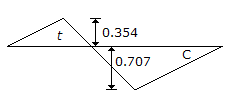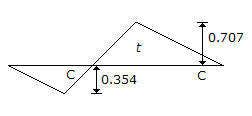Discussion
Home ‣ Civil Engineering ‣ GATE Exam Questions Comments
- Question
Plate bearing test with 20 cm diameter plate on soil subgrade yielded a pressure of 1.25 x 105 N/m2 at 0.5 cm deflection. What is the elastic modulus of subgrade?
Options- A. 56.18 x 105 N/m2
- B. 22.10 x 105 N/m2
- C. 44.25 x 105 N/m2
- D. 50.19 x 105 N/m2
- E. None.
- Correct Answer
- None.
- 1. A volume of 3.0 x 106 m3 of ground water was pumped out from an unconfined aquifer, uniformly from an area of 5 km2. The pumping lowered the water table from initial level of 102 m to 99 m. The specific yield of the aquifier is
Options- A. 0.20
- B. 0.30
- C. 0.40
- D. 0.50 Discuss
- 2. The soils most susceptible to liquefaction are :
Options- A. saturated dense sands
- B. saturated fine and medium sands of uniform particle size
- C. saturated clays of uniform size
- D. saturated gravels and cobbles Discuss
- 3. Temporary hardness in water is caused by the presence of
Options- A. Bicarbonates of Ca and Mg
- B. Sulphates of Ca and Mg
- C. Chlorides of Ca and Mg
- D. Nitrates of Ca and Mg. Discuss
- 4. Flow at critical depth takes place in an open channel When
Options- A. for a given specific energy, discharge is maximum
- B. for a given discharge, specific energy is maximum
- C. discharge is minimum for a given specific energy
- D. discharge is maximum for a given specific force Discuss
- 5. The influence line diagram for the force in member 'a' of the truss shown below is given by

Options- A.

- B.

- C.

- D.
 Discuss
Discuss
- 6. The maximum allowable compressive stress corresponding to lateral buckling in a discretely laterally supported symmetrical I beam does not depend upon :
Options- A. the modulus of elasticity
- B. the radius of gyration about the minor axis
- C. the span length of the beam
- D. the ratio of overall depth of thickness of the flange Discuss
- 7. The following general statement may be made about the penetration value and softening point of bitumen
Options- A. higher the penetration value, higher is the softening point
- B. higher the penetration value, lower is the softening point
- C. for very high and very low penetration value the softening point is very low
- D. absolutely no correlation can be drawn between penetration value and softening point of bitumen Discuss
GATE Exam Questions problems
Search Results
Correct Answer: 0.20
Correct Answer: saturated fine and medium sands of uniform particle size
Correct Answer: Bicarbonates of Ca and Mg
Correct Answer: for a given discharge, specific energy is maximum
Correct Answer:

Correct Answer: the modulus of elasticity
Correct Answer: higher the penetration value, lower is the softening point
Comments
There are no comments.More in Civil Engineering:
Programming
Copyright ©CuriousTab. All rights reserved.
